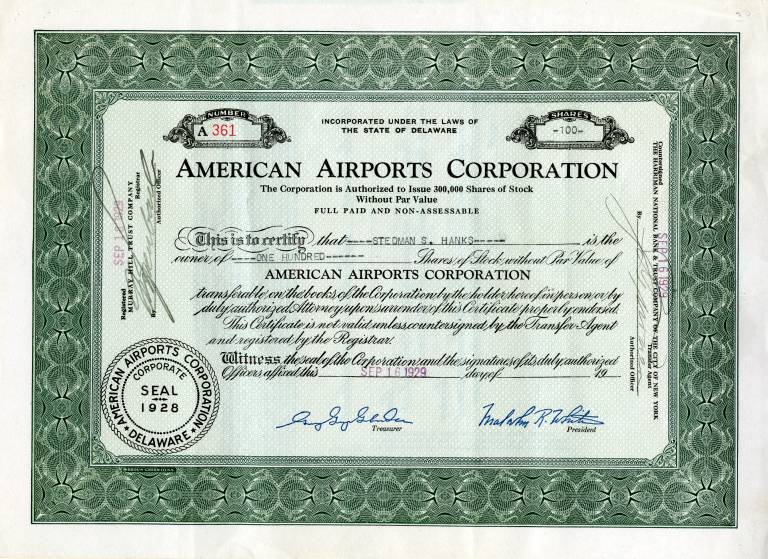Beautiful stock certificate from the American Airports Corporation This historic document has an ornate border around it with the company's name on top center. This item has the signatures of the Company's President and Secretary. 
Certificate Vignette Stedman Shumway Hanks (July 17, 1889 May 23, 1979) was one of the early aviators in the United States. After leaving active military service, he became a prolific writer and a prominent airport engineer who advocated airport construction across the United States. An early advocate of air transportation, Colonel Hanks founded and served as president of American Airports Corporation and was executive director of the Massachusetts Aeronautics Commission. In 1936 he was awarded a patent for flight strips, a new concept in auxiliary airfields, and was largely responsible for legislation passed by Congress that appropriated $10 million for their construction throughout the country. In civilian life, Colonel Hanks served in several posts with the Department of State, was associated with the American International Corporation and was president of Stedman Hanks & Company, a consulting concern. A prolific writer on aviation and foreign policy, Colonel Hanks published a number of books and articles, including "Frontiers Are Not Borders," in 1955, a discourse on the need for a foreign policy based on regional rather than global concerns. Hanks was born in Manchester-by-the-Sea, Massachusetts on July 17, 1889 to Charles Stedman and Clarina Bartow (née Shumway) Hanks. He was educated at Groton and Harvard, from which he left early to join the diplomatic service. His first post was serving as a secretary to Whitelaw Reid, United States Ambassador to the United Kingdom. After Reid's death in 1912, Hanks returned to Harvard to finish his studies, graduating with a Bachelor's degree later that year. After graduation, he returned to work in the office of the State Department, where he worked for William Phillips, with whom he had served with in London. At the outbreak of World War I, he joined the Army Air Service. In the late 1920s, concerned with the United States' inattention to building international airports, he toured Europe's airports and published his findings in 1929. In 1936, Hanks patented a flight strip, a new concept in auxiliary airfields, and helped gain government appropriation for their construction throughout the country. Through his publications and consulting work, Hanks became a prominent airport consultant during the industry's early days. In 1890, Hank's father had brought Russian Wolf-Hounds to the United States. His seven were the first to come directly to the United States from Russia, originating from the kennels of Grand Duke Peter Nikolaevich. After his father's death, Hanks remained active in Borzoi fanciers' activities and continued to fund maintenance of the kennel. History from Wikipedia and OldCompany.com (old stock certificate research service)

Certificate Vignette








